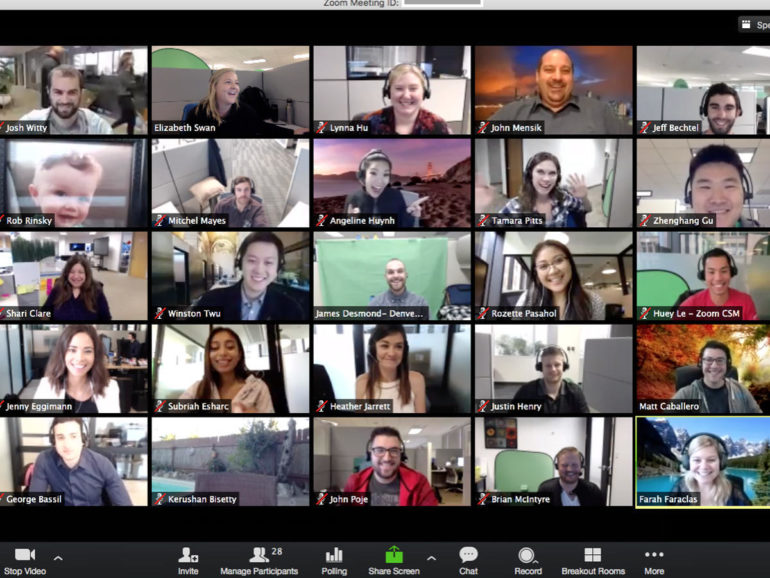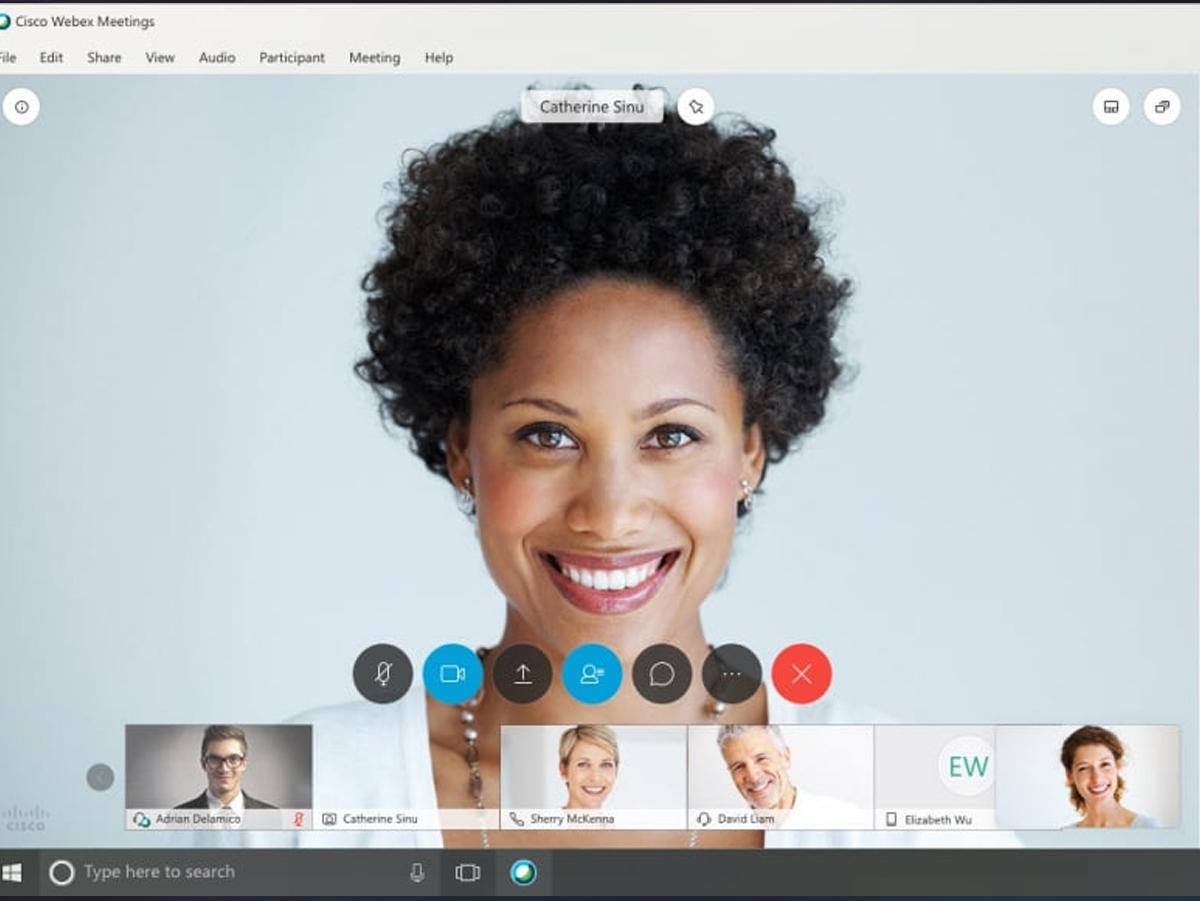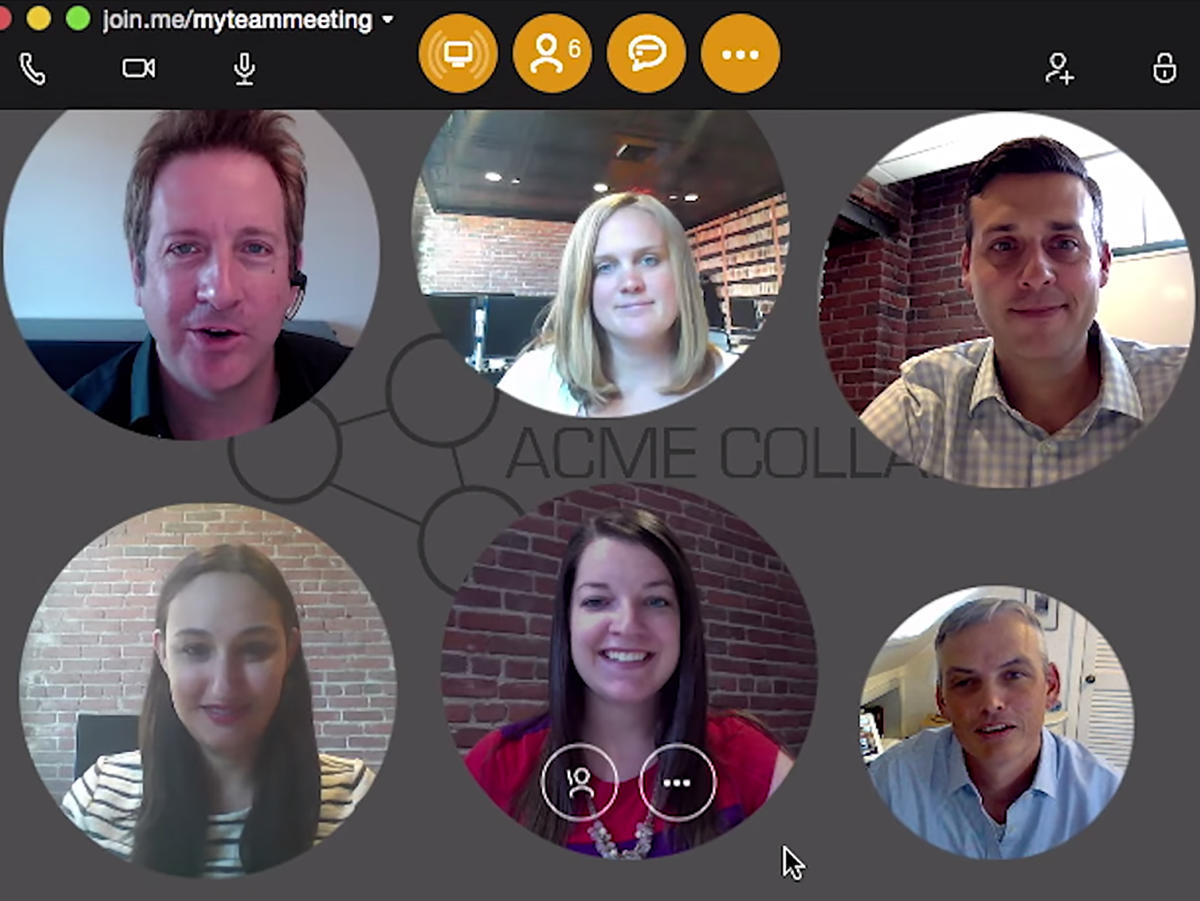It’s a provable fact, backed by scientific research, that communication is more effective when you can see the person you’re talking to. Seeing the other person’s facial expressions, for example, makes it easy to tell a serious request from an offhand remark or a joke.
But as the business world has learned since the start of the pandemic, you don’t have to brave airports and public spaces for an effective face-to-face meeting. Instead, video conferencing software and collaboration services have become the tool of choice for meetings and classes, with everyone from schoolkids to mortgage brokers to grandparents to international award show hosts learning (sometimes awkwardly) how to unmute themselves.
Using the webcam on a Windows laptop, a Mac, or a mobile device, you can meet one-on-one or with a group, no matter how widely scattered the members of your class/team/family are. We’ve assembled the leading conferencing software platforms, all capable of providing high-quality video and full-featured collaboration tools. While many of these video conferencing platforms also offer live streaming and webinar capabilities, our focus here is primarily on virtual meetings.
Note that several vendors responded to initial coronavirus concerns with free video conferencing offers. Many of those offers have since expired, but plenty of free and discounted options still exist.
The best-known video conferencing brand, by far
After a successful IPO in 2019, Zoom solidified its status as one of the leaders in the video conferencing industry, although recent security and privacy concerns have tarnished that reputation somewhat. Its conferencing software allows simple one-to-one chat sessions that can escalate into group calls, training sessions and webinars for internal and external audiences, and global video meetings with up to 1,000 participants and as many as 49 HD videos on-screen simultaneously.
Zoom sessions can start from a web browser or in dedicated client apps for every desktop and mobile platform, with end-to-end encryption, role-based user security (including HIPAA compliance), and easy-to-use screen sharing and collaboration tools. Meeting invitations integrate smoothly with popular calendaring systems, and meetings can be recorded as local or cloud-based files, with searchable transcripts.
The free tier allows unlimited 1:1 meetings but limits group sessions to 40 minutes and 100 participants. Paid plans start at $15 per month per host and scale up to full-featured Business and Enterprise plans.
New owner Verizon has cut prices and beefed up security
Billing itself as “the meetings platform for the modern workplace,” BlueJeans Meetings is a video conferencing solution that focuses on instant connections, using a mobile or desktop app or directly from a browser (with no download required). Verizon acquired the company in April 2020 and kept the quirky name, which comes from the founders’ desire to make video conferencing software “as comfortable and casual as your pair of jeans. After the purchase closed, Verizon quickly lowered prices and added a slew of new features, including support for end-to-end AES-256 GCM encryption. The company plans to “deeply integrate” BlueJeans into its 5G product roadmap.
The meeting technology, powered by Dolby Voice, includes background noise cancellation and integrates with hardware-based conference room systems as well as enterprise applications like Microsoft Teams, Slack, and Facebook Workplace. A full array of whiteboard and screen sharing tools add collaboration capabilities to any meeting. (For livestreams and large-scale web-based presentations, you’ll need a separate product called BlueJeans Events.)
After an initial free trial of the conferencing software, BlueJeans Meetings requires one of three plans, which can be billed monthly or annually, at a 20% discount. The Standard plan, designed for individuals and small businesses, costs $12.49 per meeting host per month; it supports up to 50 attendees and 5 hours of meeting recordings but doesn’t integrate with messaging apps like Slack. The Pro plan, at $17.49 per host per month or $167.88 per year, supports up to 75 attendees and includes 25 hours of cloud recordings per host. The Enterprise plan, with unlimited cloud recordings and an assortment of enterprise-focused tools, supports up to 200 attendees and requires a custom quote.
View Now at BlueJeans Meetings
Best for businesses and schools that already use Office apps
Microsoft Teams, a successor to Skype for Business, isn’t so much a product as it is a feature of Microsoft 365, which tells you a lot about its design and who its features are best suited for: businesses and educational organizations of all sizes. Anyone can sign up for the free version of Microsoft Teams using a personal email address; that tier supports up to 300 meeting participants, with guest access, one-on-one and group video and audio calls, shared files (2GB per user and 10GB per team), screen sharing, and document collaboration using online Office web apps.
Where Teams begins to deliver its full promise as a video conferencing solution is in an organization that runs on a Business or Enterprise version of Microsoft 365, where Teams is just another feature (and the successor to Lync and Skype for Business). In that environment, administrators have access to a full range of management, security, and compliance tools. Team members can share files (up to 1TB per user), schedule meetings directly from Outlook, record meetings, and collaborate on documents using the desktop Office programs and SharePoint Online. Those paid plans also support online training sessions and webinars.
Microsoft 365 plans start at $5 per user per month, and Redmond has been rolling out new features at a steady clip for the past year. For organizations that aren’t deeply embedded in the Microsoft way of working, the Teams feature set can be baffling. But for anyone who already lives in SharePoint and Outlook, Microsoft’s conferencing software should be a tight fit.
A pioneer of remote software broadens its horizon
LogMeIn has been on an acquisition tear in recent years, with GoToMeeting and a collection of related collaboration tools acquired from Citrix back in 2016. A major update to the video conferencing software released in late 2019 includes a long list of new features and what LogMeIn calls “a completely reimagined product” that works in a web browser (no download required) or through desktop and mobile apps. After a 14-day free trial, you’ll need to choose a paid plan; options include Professional ($12 per organizer per month, up to 150 participants) and Business ($16 per organizer per month for up to 250 participants). An Enterprise plan supports up to 3,000 participants.
The reworked user experience in LogMeIn’s GoToMeeting conferencing solution is consistent across platforms and integrates with calendar solutions and platforms from Office 365, G Suite, Salesforce, Zoho, and Slack. For each call, you can take notes in real-time, which are then embedded and saved in the meeting transcript. Besides the normal option to save to video, you can also capture presentation slides from a meeting and share them in a PDF for later download.
A completely browser-based alternative
Since its founding nearly a quarter-century ago, Zoho has grown to 50 million users worldwide. Its flagship product is Zoho One, a web-based suite of services and mobile apps designed to tie together sales, marketing, accounting, HR, and operations. Zoho Meetings offers tools for webinars, training, and online meetings, with plans starting at $10 per host per month (or $8 per month if you pay for a full year). The price tag of this video conferencing solution includes support for up to 100 participants and storage for 10 recorded meetings.
On PCs and Macs, Zoho Meetings is a completely browser-based conferencing solution, with no downloads required. For audio, participants can dial in over the phone (toll-free numbers are an extra-cost option), and in-session chat is available as well. Meetings can be recorded from any endpoint, including mobile devices. Zoho says the service is GDPR-compliant and is certified to the Privacy Shield Frameworks; more granular privacy tools include the ability for moderators to lock meetings and mute or eject participants. Although the video conferencing service integrates with Google Calendar, its primary strength is for organizations that are already invested in Zoho’s CRM and Projects tools.
Nobody ever got fired for choosing Webex
Webex is truly one of the graybeards of the video conferencing software segment, founded in 1995 and acquired by Cisco in 2007. The free conferencing plan (up to three users) is surprisingly full-featured, with HD video, screen sharing on desktop and mobile devices, and limited recording options; it supports up to 50 participants per meeting, with meeting times capped at 40 minutes and online storage limited to 1GB.
If the limitations of the free tier get in your way, three paid plans are available: Starter ($13.50 per host per month, 50 attendees), Plus ($17.95 per month, 100 attendees), and Business ($26.95 per month, with a five-license minimum, supporting up to 200 attendees). Enterprise plans are also available. Each step up includes additional cloud storage and management features; single sign-on and support for Exchange and Active Directory requires the Business plan. An interesting add-on, Call Me, allows you to start a meeting by receiving a phone call; you’ll pay $4 per host per month for this feature for domestic calls, with the tariff for international calls going up to a pricey $35.75 per month.
Best for those on a tight budget
This member of the LogMeIn family should be on the video conferencing software shortlist for businesses on a tight budget. Audio meetings with screen sharing for up to three participants are free, with a unique interface that puts each participant’s face in a bubble that bounces around the screen. Paid conferencing plans start with Lite ($10 per host per month, five meeting participants, no time limits), with no webcam streams but support for screen and window sharing. Upgrading to Pro ($20 per month) increases the number of meeting participants to 250 and adds 50GB of cloud storage plus recording options. Go to the $30 -per-month Business plan for 1TB of storage, single sign-on support and Salesforce integration.
It’s unclear whether Join.me will thrive in the shadow of its bigger sibling, GoToMeeting, but for now, at least, it has an identity all its own.
Big-time services from a company that’s not too big
AnyMeeting has been around for nearly a decade, and the video conferencing software’s user base had grown to more than 1 million when the company was acquired in 2017 by Intermedia. Today, AnyMeeting is available as part of Intermedia Unite, a unified communication and collaboration platform that integrates its video conferencing, chat, and screen sharing functions into a cloud-based service that also includes VOIP capabilities and an enterprise-grade PBX system. If that’s overkill for your small business’ video conferencing needs, AnyMeeting is available separately in Lite and Pro plans that cost $10 and $13 per user per month, respectively.
Video conferencing software features are essentially the same between the two plans, with the ability to create custom meeting URLs, schedule recurring meetings, and integrate with productivity tools from Google, Microsoft, Slack, and others. HIPAA compliance and end-to-end encryption are standard features as well. Upgrading to a Pro plan increases the number of web-based participants from 10 to 30 (but a maximum of 12 in Full HD). The Pro plan also includes the ability to record and transcribe meetings and unlimited cloud storage of meetings.
We’ve been a big fan of Intermedia for years, precisely because it offers the option to use big-time software and services from a company that’s not too big to care.
View Now at Intermedia AnyMeeting
Designed to work in Chrome browser
Google’s ever-evolving lineup of communications and collaboration apps split in two back in 2017, with the classic version of Google Hangouts video conferencing marked for retirement. Google Hangouts Meet is the business version, enabling video meetings for G Suite subscribers. External participants can also connect.
Naturally, the service is designed to work in the Google Chrome browser (although limited support for Internet Explorer 11 is also available), with mobile apps available on iOS and Android. The exact feature set depends on your G Suite version; the number of participants, for example, is limited to 100 for G Suite Basic, 150 for Business, and 250 for Enterprise. For live streaming (up to 100,000 audience members) and the ability to record meetings and save them to Google Drive, you’ll need G Suite Enterprise.
If your business is standardized on Google’s productivity and email tools, this video conferencing option should be on your shortlist.
View Now at Google Hangouts Meet
Video calls only on desktop platforms
If your organization has a paid workspace that uses Slack’s collaboration tools, you already have access to a handful of limited video calling options that might be good enough for basic meetings and team collaboration needs. Just be aware that video calls are available only on desktop platforms (Mac, Windows, and Linux); the iOS and Android apps are limited to voice calls only.
For the full range of screen-sharing features, including options to stream presentations and draw on a shared screen, you’ll need the Slack app. With Google Chrome (the only supported browser), you can view a teammate’s screen, but you can’t start a screen share. The company’s support site warns Mac users to download the Slack app from its website for full access to screen sharing features, which are not available in the App Store version.
What to look for when evaluating video conferencing solutions
What should you look for when putting video communication software to the test? After a full year of empty offices and no-travel orders, most companies have realized that remote work and online meetings can be extremely effective and are likely to demand much more from these tools than the basic feature set that might have been sufficient in pre-pandemic times.
We narrowed down the list of contenders in this guide using the same criteria we recommend you take into account when you’re in the market for one of these services. Think of our list as a starting point to help you organize your search: One or more of the products that didn’t make our cut might well deserve to be on the shortlist for your business needs.
Our most important criteria was reputation. Every product on this list has a solid track record in terms of performance and reliability. We were pleasantly surprised, in fact, to find some firms in this business that have been going strong for more than two decades.
In business terms, we know that our readers represent a broad swath of sizes, shapes, and cultures. So we went out of our way to find a mix of products that work for cash-conscious small businesses (three of them are free, in fact, for organizations with three people or fewer). For slightly larger organizations, including schools, we’ve tried to highlight commercial plans that are reasonably priced if you can live with their limits, such as the number of meeting participants and the length of each meeting.
Others offer high-end options ideal for large companies that want control over livestreams and training sessions involving large audiences. The biggest differentiator here is the number of people you can have in the audience. That makes sense for organizations that do webcasts and presentations to large numbers of employees, customers, or members on a worldwide basis. Those plans are where you’re much more likely to find support for advanced features like full recording options and the ability to generate a PDF from the slide deck that powered your online session.
If all you want is the ability to talk face to face, with the occasional bit of screen sharing and whiteboarding, you have plenty of choices. If you want to make those sessions available for replay online, you’ll need to look carefully at the cloud file storage options associated with each plan.
As you’ll see from this list, you might already have access to effective tools because of subscriptions you’re already paying for. We included three popular names from that group: Microsoft 365, Google’s GSuite, and Intermedia’s Office in the Cloud. (A fourth option, Slack, is excellent for messaging and 1:1 calls but doesn’t have the feature set to compete with the other products on this list.) Shops that have standardized on one of those plans might find that the included conferencing and communication features are the ideal way to keep your company connected without extra deployment and training costs.
Finally, we considered the sorts of features that reduce friction in using this type of product. That list includes integration with other software you currently use, such as seamlessly connecting an online meeting to your calendar and your organization’s directory. And then there are ease-of-use features, including the ability to connect from a browser instead of being forced to download a client app or plug-in, and the ability to invite external participants to meetings.












